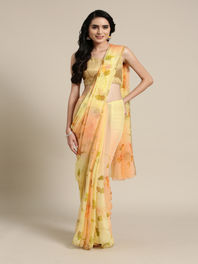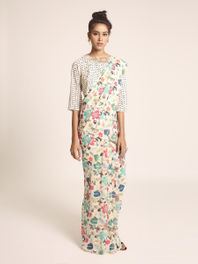
Benarasis, bomkais, garas, patolas, Paithanis, Kanjeevarams, kasavus – whichever one of its thirty variants you may know it by, if there’s one silhouette that comes the closest to embodying our country, it’s the sari. Let’s admit it, growing up, most of us have admired our mothers and grandmothers, wrapped in their deftly draped saris and have wished we too could look as full of grace and charm as they did. While some of us were blessed with this mise-en-scène only on special occasions like Durga Puja or Diwali, the other more fortunate ones would get greeted by their sari- clad mothers every morning, all set to head to work, suitcases in tow. Whatever your case may be, there’s no denying that through the years, this silhouette whose origins can be traced as back as 1800 BC, has continued to be the cultural uniform of our country and symbolised the coming-of-age of most Indian women. Below, ten phenomenal powerhouses across ages and professions explore their relationship with this all-too-important silhouette and share with us, everything from how they came upon the sari to how they make the it their own to what the six-yard (in some cases nine-yard) staple means to them – read on to find out all this and so much more…

To Sukanya, the sari is the “ultimate embodiment of feminine glory – elegant and powerful.” A quick glance at her wardrobe and you’ll find some of the choicest saris there are, “I still cherish my first sari which was a powder blue, crystal embroidered number that my aunt got specially made at a zariwala. Being a Tambram, I love getting customised Kanjeevarams from the little temple town of Kanjeevaram in Tamilnadu. You’ll also spot several pure Chantilly lace saris from Dubai in my closet,” says the mother of one who doesn’t shy away from injecting a decadent dose of designer labels to her sari collection from time to time, “Raw Mango, Ratanshi Kheraj and Ekaya are my go-to labels for timeless pieces. Tarun Tahiliani, Sabyasachi, Anita Dongre for fashionable finds and Gaurav Gupta and Satya Paul for statement saris,” she says. Such is her penchant for the six-yard staple that ask her to pick her favourite of the lot and she can’t stop at just one, “There are so many! An organza sari with watercolour floral print and Swarovski encrusted border that my elders gifted me on my traditional baby shower. There’s also my mother’s gorgeous Ashdeen purple gara that I adore,” Her advice to amateur sari wearers? “Invest in a great, stretchy but structured sari petticoat. And you won’t need a million safety pins to hold the sari in place,” says Shah.
– Sukanya Shah, Freelance Content Creator

“I was twelve when I first wrapped myself in my mother’s sari to look older because I wanted to sneak my way into the cinema that was showing an adult film!” jokingly recollects Maya Alagh of her first brush with the traditional silhouette. Since then she’s embraced the sari through the early noughts and well into her late years with a few simple yet signature touches, “Even today, when I step out of my house every evening, you’ll find me in my airy chiffon or georgette saris complete with pearls and a big bindi,” says the mother of two. Daughter, Anjori Alagh on the other hand thanks her mother for teaching her everything she knows about the six-yard staple, including a game changing lesson she learnt from her mother early on, “I must be in the fourth grade when I had to wear a sari for a school play and I obviously depended on my mother to drape it on me. What she told me that day about the sari remains etched in my memory. She said that the last pleat of the sari can make or break the look. If not done properly, you could stumble and fall, dishevelling the sari, stripping away the grace it holds,” says the entrepreneur whose preference of the sari aligns with her mother’s but not without minor modifications, “Like my mother, I too veer towards lightweight saris – they sculpt my body beautifully. Except I like to wear mine with sexy blouses,” she says. It only makes sense then that Maya has the most delicate sari saved for her second-born, “There’s a Benarasi Tangail that I have kept aside for her, it’s a cotton sari but it feels like air. Unfortunately, there are only about seventeen weavers left in this country who make these saris anymore so it would make for a priceless possession,” says the veteran actor.
– Anjori Alagh, Entrepreneur and Maya Alagh, Actor

“The sari brings to my mind everything Indian – the colours, chaos and ethos of this country!” says Bahl whose earliest and warmest memory of the sari was that of her mother on a Diwali night, “When I was about nine or ten, my mother wore this gold satin silk sari for Diwali and she looked so radiant in it that for about three or four Diwalis that followed, every year she’d take out that one sari. To me that became the symbol of Diwali,” she smiles. For someone who finds her fashion icons in political figures such as Indira Gandhi, Brinda Karat and Maharani Gayatri Devi, Bahl’s style of wearing saris oscillates between offbeat and classic – offbeat for the chunky silver accessorizing and classic for her conventional leanings. This somewhat explains her decision of opting to be a sari bride instead of the commonplace lehenga one,” I didn’t relate to the lehenga, I always knew I would wear a sari when I would tie the knot. I wore a Kanjeeravaram with a Sabyasachi blouse for my wedding last year,” says the thirty-one-year-old who routinely enjoys wearing handloom saris sourced from all over the country and a few others borrowed from her late grandmother’s trunk. Of those, if there’s one sari that stands out to her the most, its “an organza sari with hand painted motifs that was passed down to me when my grandmother passed away, it’s the prettiest sari I’ve owned till date,” says Bahl.
– Vibhuti Bahl, Designer, Roha
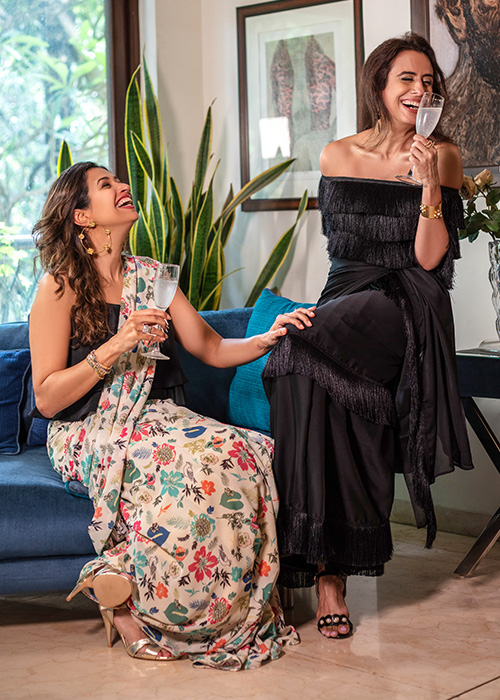
They may not agree on many things but the one firm favourite that forges the foundation of their friendship is cocktail saris – the two are often spotted together wearing the chicest six-yard styles at the swankiest party postcodes. Even then, they both differ in their predilections – while Dalwani reaches out for bolder hues and unconventional pairings, Khambata is often seen in subdued tones and lace-laden options, “Dilshad loves lighter colours but I love to wear darker hues. She loves lace and I’ve never really tried it,” testifies Dalwani,” I go for lots of georgettes and crepes and pair them with edgy blouses while Sonali sometimes likes her saris rooted in tradition,” adds Khambata. She isn’t entirely mistaken in saying so because Dalwani’s most cherished saris include a pink Benarasi she wore for her parent’s twenty fifth anniversary and an old jamevar she inherited from her mother on her wedding. The secret to taking the traditional silhouette to a boozy brunch or to the after- hours, however, lies in a few clever tricks, “I wear my saris well below the belly button for a sensual appeal and drape the pallu around my neck or my arms to add oomph. I also always put a little pleat on my first round on both sides because that gives you a little more room for movement making the sari dancefloor-friendly,” says Dalwani.
– Sonali Dalwani, Footwear Designer, Crimzon and Dilshad Khambata, Director, Cuisinart
Restaurants
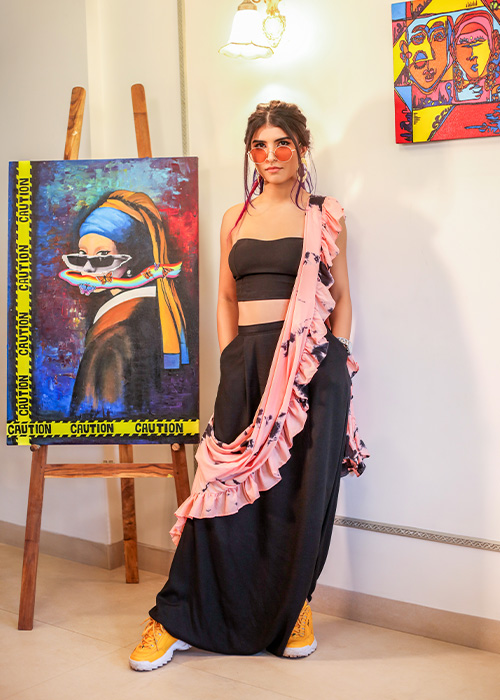
“The sari makes me feel badass and stands as an example of pulling off difficult things with ease!” says Irani who, like most twenty-somethings, stumbled upon the world of saris by more of a chance and less of a choice, “Because I’m a Parsi, when I entered my teens, I had a sari pervanu ceremony in my house with all my friends and relatives who came together to embarrass me. I vividly remember, standing in a blouse and petticoat on stool while everyone had their eyes on me, and I had to wear the sari in front of them. I can never delete that day from my memory,” she says. The said episode might not have been her most fond one but it did leave Irani wanting to wear the sari more often. Albeit wrapping herself in the ‘restrictive’ silhouette on the daily still remained a farfetched possibility, she decided to commit herself to sari for all occasions that called for a traditional dress code, even if it meant wearing a readymade version of it. Then again, are you even a millennial if you don’t add new-age applications to every outfit you own? And so she did too, to all her and her mother’s saris, after all, it went well with her street-cred cool image, “I can proudly say that the one thing I can do in a sari that no one else can is pull it off with a pair of sneakers and dance in it with reckless abandon for a whole night,” says Irani.
– Sanaaya Irani, Make-up Artist and Fine Artist
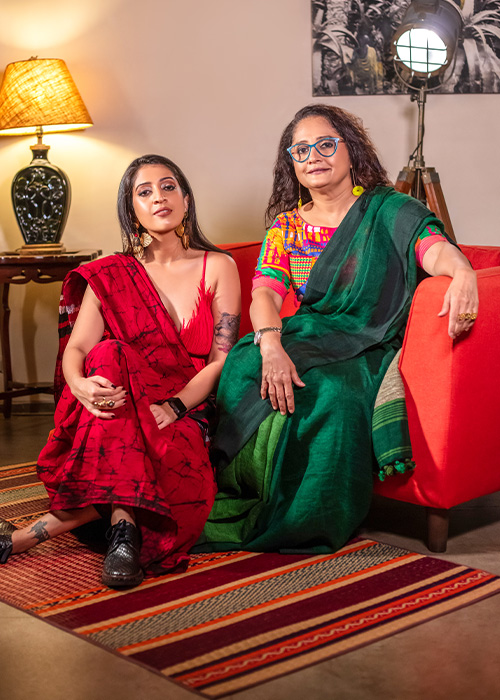
“My sari style is definitely 90’s Raveena Tandon meets biker chic,” says Sanjana who has frequently fallen back on Bollywood for sartorial inspiration, “My first idea of the sari stemmed from Sushmita Sen in Main Hoon Na. I thought I was going to look like that except that I was hobbling and struggling and there was weird fat sticking out of my back the first time I wore it,” jokes the thirty-one-year-old. Like most daughters, she too depends on her mother to drape the sari on her, so much so that the one time her mother wasn’t able to do the needful, it went down as the most memorable moment in her sari wearing history, “I tried draping it myself, but it looked untidy and came undone amidst my dance performance. I can never forget that night, it made me realise how dependant I am on my mother!” This fuelled Sanjana to part with convention and invest in a few pre-stitched saris designed by her close friend, Neti Jolly despite the umpteen disapproving looks she received from her ardent sari-wearing mother who can be spotted in a pared back cotton number on any given day, “Saris represent my roots and my culture to me – I love wearing handloom saris that let me breathe and have an artisanal aspect to it. That said, my style is anything but stereotypical – when paired with bright shirts or crop tops, my saris get a modern makeover,” says Sangeeta. The one thing her daughter has taught her about the sari? “That it’s okay to have ruffles and tassels on it and to have dhoti versions of it.”
– Sanjana Chowhan, Erotica Writer and Sangeeta Chowhan, Porcelain Artist

“The sari is a versatile silhouette – it can look equal parts powerful and seductive” says Bhatia. She was all of twenty-three when saris started to take centre stage in her closet, “My first job was at the Times Of India and the dress code was saris—they made a strong statement. Funnily, I didn’t possess a single sari – we were all into western workwear – so every week my mother would hand me over a batch of five crisp and pressed saris with matching blouses. That way I never had to repeat a sari for as long as I remember.” However, her meet-cute with the sari was no mean feat – even though she was in awe of her sari-wearing mother since childhood; she struggled with draping it the first few times. Being the strong-headed woman she is, she wholeheartedly welcomed all kinds of saris in her wardrobe – from leheriyas to cottons to chiffons, she gave them all a go. Cut to the present, she has mastered the sari to a point where she can wrap it around in under three minutes and what’s more, can also boast of creating her own, “Lately I’ve started making my own saris. I take two contrasting fabrics, be it print or colour and get them stitched together with different yards of cloth,” says Bhatia who refrains from pinning her saris and likes to let them flow freely retaining their natural form. While Benarasis might always remain her preferred choice of a sari, the one she cherishes the most is a contemporary piece she designed for herself, “It’s a half and half pink and purple linen sari – people look at it and ask me if it’s a Missoni!” quips Bhatia.
– Almona Bhatia, Publisher, GQ
Follow @NykaaFashion on Instagram for more!



